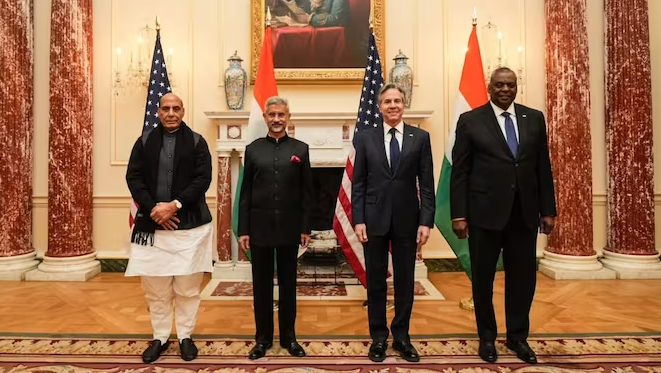The fifth edition of the India-United States Ministerial Dialogue, held annually, underscored the collaborative commitment to address China’s assertiveness and prioritise security in the Indo-Pacific region. The timing of the 2023 meeting had particular significance as both nations sought to establish shared approaches to managing pressing global geopolitical challenges. While Washington concentrated on conflicts in Gaza and Ukraine, concerns surrounding Taiwan, and the escalating Chinese presence in the Indo-Pacific, the United States is navigating strategic pressures simultaneously on multiple fronts. Consequently, it seeks support from diverse allies and partners to manage its security responsibilities collectively.
“We are meeting at a time of great momentum in the United States and India partnership,” remarked Secretary of Defense Lloyd Austin while adding, “in the face of urgent global challenges, it is more important than ever that the world’s two largest democracies exchange views, find common goals, and deliver for our people.”
Sharing the perspectives of his US counterpart, Defence Minister Rajnath Singh said that defence relations are one of the important pillars of bilateral relations between India and the United States.
“We (India and the United States) find that our two countries are increasingly aligned on strategic issues, including countering China’s aggression and promoting freedom and openness. Indo-Pacific region and addressing regional security challenges. We share a common focus on maritime security in the Indo-Pacific region and recognise the importance of protecting critical sea lanes and promoting stability,” Singh observed.
Secretary of Defense Austin underscored the “remarkable progress” made in the defence partnership over the preceding year. He emphasised that these advancements will not only aid in maintaining peace and stability but will also enable both nations to make even greater contributions collectively. Secretary Austin highlighted key aspects of collaboration, including integrating industrial bases, reinforcing interoperability, and exchanging cutting-edge technology. He further remarked on the extensive scope of cooperation, spanning from the depths of the sea to outer space.
“We are integrating our industrial base, strengthening our interoperability and sharing cutting-edge technologies,” Austin said.
The annual meetings between India and the United States have been held since 2018 to discuss common issues of concern with the goal of bolstering ties between the two countries. The two leaders met with their respective counterparts – India’s External Affairs Minister, Subrahmanyam Jaishankar, and India’s Defense Minister, Rajnath Singh, in New Delhi on 10 November.
The Indo-Pacific emerged as a focal point during the 2+2 discussions in New Delhi. Experts emphasised the crucial role of the Indo-United States partnership in enhancing both regional security and the fortification of democracy. The US Secretary of State Blinken articulated the commitment to advancing a free, open, prosperous, secure, and resilient Indo-Pacific, underscoring the strengthening of collaboration through the Quad involving Japan and Australia. He positioned the trip as part of an intensive phase of American diplomacy in the Indo-Pacific, with a specific effort to reaffirm the significance of the US–India relationship for the stability of the region.
Following the meeting between Blinken and PM Modi, State Department spokesperson Matthew Miller highlighted that the discussions reaffirmed a “shared vision” for a robust partnership in the Indo-Pacific and on matters of global significance. The term “shared” featured prominently, reiterating seven times across five State Department releases following the November 10th meeting. Miller elaborated on the leaders’ commitment to collaborative action, stating, “they underscored their commitment to addressing ongoing crises such as Russia’s conflict with Ukraine and the turmoil in the Middle East.”
The capability of the partnership between India and the United States was showcased through PM Modi’s visit to the U.S. in June and President Biden’s attendance at the G20 summit in India in September. Jaishankar noted that the timing of the subsequent 2+2 meetings following these constructive visits, played a significant role in nurturing what he referred to as “a forward-looking partnership” with a “shared global agenda.”
Former Cold War adversaries, the United States and India are currently achieving milestone agreements, encompassing the US provisions and manufacture of engines for Indian fighter jets, the supply of MQ-9 “Predator” drones, and collaboration in semiconductor manufacturing. This summer saw a significant enhancement of their strategic partnership, culminating in finalising a roadmap for defence industry cooperation. Noteworthy areas of technical collaboration include intelligence, surveillance, and reconnaissance, undersea domains, air combat, land combat mobility systems, and ammunition systems.
Ravi Shankar






















